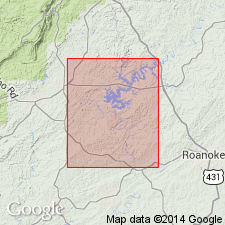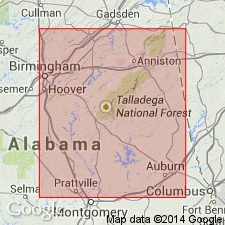
- Usage in publication:
-
- Mad Indian Group
- Modifications:
-
- Named
- Dominant lithology:
-
- Schist
- Gneiss
- AAPG geologic province:
-
- Piedmont-Blue Ridge province
Summary:
Mad Indian Group is here named in Clay and Randolph Cos, east-central Alabama. Group is not formally subdivided, but consists of informal graphitic and non-graphitic units. Described as fine-grained feldspathic biotite gneiss and medium- to coarse-grained muscovite-biotite-garnet schist. Unit is extensively cut by feldspathic dikes, pegmatites, and small granitic bodies. Generalized age is Paleozoic.
Source: GNU records (USGS DDS-6; Reston GNULEX).

- Usage in publication:
-
- Mad Indian Group
- Modifications:
-
- Revised
- AAPG geologic province:
-
- Piedmont-Blue Ridge province
Summary:
Author here proposes that Ashland Mica Schist, as used by Adams (1926), be elevated to supergroup status to incorporate the groups of the Coosa block in east-central Alabama. Ashland includes Poe Bridge Mountain and Mad Indian Groups in the northeastern part of the study area (Clay, Randolph, and Cleburne Cos) and the correlative Higgins Ferry and Hatchet Creek Groups in the southwestern part (Coosa and Chilton Cos). The contact between the Mad Indian and Poe Bridge Mountain Groups and between the Higgins Ferry and Hatchet Creek Groups appears to be stratigraphic rather than tectonic, but relative age of units is undetermined.
Source: GNU records (USGS DDS-6; Reston GNULEX).
For more information, please contact Nancy Stamm, Geologic Names Committee Secretary.
Asterisk (*) indicates published by U.S. Geological Survey authors.
"No current usage" (†) implies that a name has been abandoned or has fallen into disuse. Former usage and, if known, replacement name given in parentheses ( ).
Slash (/) indicates name conflicts with nomenclatural guidelines (CSN, 1933; ACSN, 1961, 1970; NACSN, 1983, 2005, 2021). May be explained within brackets ([ ]).

